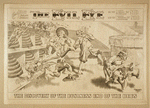Today's quote comes from Michael Sappol's study of the rise of anatomy as a medical discipline in the nineteenth century and its relationship to racial, gendered, and class-based identity politics. This study moves fluidly from the dissection table to the funeral parlor, dime museum, and literary works and treatises to trace the complex way in which nineteenth century persons located identity within the body. Here Sappol considers the role of funerary practice in securing the meaning of selfhood:
"If death was a haven in a heartless world, then here the anatomist and the grave robber willfully transgressed. Against the invasion of the body snatchers, the living struggled mightily to protect the honor of their dead, to safeguard the material integrity of their helpless dead selves, to narrate their lives and therefore their deaths. For them selfhood did not terminate with death; rather, death stripped away the duplicitous masks and inessentials of being, leaving an existentially pure residue. Post-mortem photoportraiture, which from the earliest days of photography emerged as one of the most popular genres of the new medium, was intended not so much for spectatorship, but to freeze the self into an iconic last frame--many of the pictures were tucked away as keepsakes, never meant to be displayed, viewed only infrequently or not at all. Nineteenth-century Americans of all classes took this very seriously: how one died fixed symbolically how one lived"(39).
--Michael Sappol, A Traffic of Dead Bodies: Anatomy and Embodied Social Identity in Ninteenth Century America (2002)
Monday, October 5, 2009
Boundaries Part V: Dead Bodies
Labels:
body snatchers,
death,
keepsakes/talismans,
life,
photography
Subscribe to:
Post Comments (Atom)






No comments:
Post a Comment